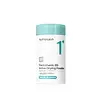What's inside
What's inside
 Key Ingredients
Key Ingredients

 Benefits
Benefits

 Concerns
Concerns

 Ingredients Side-by-side
Ingredients Side-by-side

Water
Skin ConditioningGlycerin
HumectantCalamine
AbsorbentBentonite
AbsorbentButylene Glycol
HumectantZinc Oxide
Cosmetic Colorant1,2-Hexanediol
Skin ConditioningKaolin
AbrasivePanthenol
Skin ConditioningLactobacillus/Licorice Root Extract Ferment Filtrate
Skin ConditioningPEG-60 Hydrogenated Castor Oil
EmulsifyingXanthan Gum
EmulsifyingSulfur
AntiseborrhoeicHydroxyacetophenone
AntioxidantVolcanic Ash
AbrasiveLactobacillus/Centella Asiatica Extract Ferment Filtrate
Skin ConditioningLeptospermum Petersonii Oil
MaskingAsiaticoside
AntioxidantMentha Haplocalix Extract
MaskingMadecassic Acid
Skin ConditioningAsiatic Acid
Skin ConditioningMenthyl Lactate
MaskingScutellaria Baicalensis Root Extract
AstringentCitral
PerfumingCitronellol
PerfumingGeraniol
PerfumingWater, Glycerin, Calamine, Bentonite, Butylene Glycol, Zinc Oxide, 1,2-Hexanediol, Kaolin, Panthenol, Lactobacillus/Licorice Root Extract Ferment Filtrate, PEG-60 Hydrogenated Castor Oil, Xanthan Gum, Sulfur, Hydroxyacetophenone, Volcanic Ash, Lactobacillus/Centella Asiatica Extract Ferment Filtrate, Leptospermum Petersonii Oil, Asiaticoside, Mentha Haplocalix Extract, Madecassic Acid, Asiatic Acid, Menthyl Lactate, Scutellaria Baicalensis Root Extract, Citral, Citronellol, Geraniol
Distarch Phosphate
AbsorbentSilica
AbrasiveZinc Oxide
Cosmetic ColorantNiacinamide
SmoothingPantothenic Acid
Skin ConditioningMaltodextrin
AbsorbentAllantoin
Skin ConditioningPueraria Lobata Root Extract
HumectantDipotassium Glycyrrhizate
HumectantPiper Methysticum Root Extract
Skin ConditioningMadecassoside
AntioxidantAsiaticoside
AntioxidantHydroxypropyl Cyclodextrin
MaskingSalix Alba Bark Extract
AstringentPunica Granatum Pericarp Extract
Skin ConditioningWater
Skin ConditioningDextrin
AbsorbentDistarch Phosphate, Silica, Zinc Oxide, Niacinamide, Pantothenic Acid, Maltodextrin, Allantoin, Pueraria Lobata Root Extract, Dipotassium Glycyrrhizate, Piper Methysticum Root Extract, Madecassoside, Asiaticoside, Hydroxypropyl Cyclodextrin, Salix Alba Bark Extract, Punica Granatum Pericarp Extract, Water, Dextrin
 Reviews
Reviews

Ingredients Explained
These ingredients are found in both products.
Ingredients higher up in an ingredient list are typically present in a larger amount.
Asiaticoside comes from the super popular skin-soothing ingredient, Centella asiatica. It is one of four active compounds found in the extract of Centella Asiatica.
Asiaticoside is an antioxidant and helps with wound healing. It has been shown to increase antioxidant activity during the wound healing process.
Water. It's the most common cosmetic ingredient of all. You'll usually see it at the top of ingredient lists, meaning that it makes up the largest part of the product.
So why is it so popular? Water most often acts as a solvent - this means that it helps dissolve other ingredients into the formulation.
You'll also recognize water as that liquid we all need to stay alive. If you see this, drink a glass of water. Stay hydrated!
Learn more about WaterZinc Oxide is a mineral broad-spectrum UV filter; it is the broadest UVA and UVB reflector approved by the FDA. It also has skin protectant and skin soothing properties.
Zinc oxide is one of the most effective broad-spectrum UV filters. It protects against UVB, UVAII, and UVAI. In comparison to its counterpart titanium dioxide, zinc oxide provides uniform and extended UVA protection.
Another great benefit? This ingredient is highly photostable so it won't degrade easily under sunlight.
A common myth is that mineral UV filters are widely believed to primarily reflect UV light.
However, modern research shows titanium dioxide absorbs UV radiation like chemical filters (~95% absorption & 5% reflection).
Zinc oxide has great skin soothing properties so you'll likely find this in sunscreens formulated for sensitive skin or babies/children. It is unlikely to cause "eye sting" like other sunscreen ingredients.
Regulatory agencies consider zinc oxide to be non-toxic and safe. It has also been shown to not penetrate the skin.
Unfortunately, this ingredient does leave a visible white cast. This is why mineral sunscreens are often less cosmetically elegant than chemical or hybrid ones.
In cosmetics, zinc oxide can be found in both non-nano and nano-sized forms. The nano version is used to reduce white cast and improve the texture of sunscreen formulas.
There are ongoing concerns surrounding nano-zinc oxide's impact on marine ecosystems and whether it can be absorbed into skin.
Regarding marine ecosystems and coral reefs, there is no conclusive evidence that any form of zinc oxide (or any other sunscreen ingredients) will cause harm. The science is still developing but many consumers are keeping a close eye on this issue.
Please note, many destinations have reef-safety sunscreen rules. For instance, the U.S. Virgin Islands advises all visitors to use non-nano mineral sunscreens.
There has also been some stir about whether micronized or nano zinc oxide has potential photoxicity and absorption through the skin/lungs.
An in-vitro (done in a test tube or petri dish) study demonstrated micronized zinc oxide to have potential phototoxicity. There's no need to fret; the EU Commission's Scientific Committee on Consumer Safety has stated, "The relevance of these findings needs to be clarified by appropriate investigations in vivo." Or in other words, further studies done on living organisms are needed to prove this.
Current research shows zinc oxide nanoparticles do not penetrate intact or sunburned skin. They either remain on the surface or in the outermost layer of dead skin (stratum corneum).
Zinc oxide is one of only two classified mineral UV filters with titanium dioxide being the other one.
Fun fact: Zinc has been used throughout history as an ingredient in paint and medicine. An Indian text from 500BC is believed to list zinc oxide as a salve for open wound. The Ancient Greek physician Dioscorides has also mentioned the use of zinc as an ointment in 1AD.
Learn more about Zinc Oxide